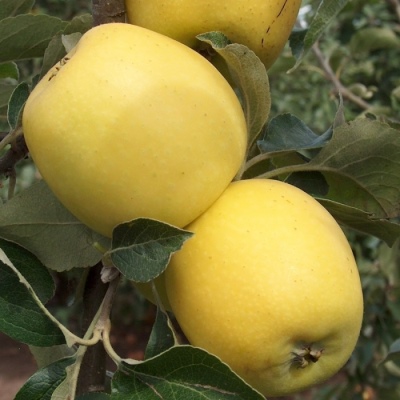
- Authors: Kazakh Research Institute of Fruit and Viticulture
- Taste: sweet, no sourness
- Fruit weight, g: 150-250
- Yield: for 5 years, you can get up to 25 kg annually
- Ripening terms: late winter
- Removable maturity: at the end of September
- Keeping quality: I'm at home
- Appointment: universal
- Growing regions: Siberia, Black Earth, Middle zone
- Appeared when crossing: Aport x Golden Delicious
The apple tree is a fruit tree that is grown by almost everyone on their backyard plots. Particular preference is given to varieties with high yields, which do not require special skills for growing and care. This includes the Ainur variety.
Breeding history of the variety
The origin of this apple variety is Kazakhstan. It was there that by crossing Golden Delicious and Aporta everyone's favorite apple variety Ainur was obtained. Working for a long time, Kazakh breeders have ensured that the Ainur apple tree adapts well to different climatic conditions.
Description of the variety
Ainur is a medium-sized apple tree that grows up to 2.5-3 meters in height, while its rounded crown is quite compact, moderately spreading, so the tree does not take up much space. Active growth of branches is observed in the first few years, and then slows down.
Features, pros and cons
The Ainur variety is the king of winter varieties, which is characterized by good winter hardiness, unpretentious care, abundant harvest and long-term preservation of fruits, due to which delicious apples can be enjoyed until spring.
The advantages of the variety are good survival rate of seedlings, immunity to fungal diseases and excellent taste of apples. There are practically no disadvantages of this species.
Ripening and fruiting
The flowering of the tree begins in the second half of May and lasts for 7-10 days. It is the late flowering that has a positive effect on the abundance of the harvest, since frosts are no longer observed at the end of spring. Fruit ripening begins in the second half of September. Apples ripen at the same time, which makes them easier to pick. Despite the abundance of fruits on the branches, they do not crumble, which has a positive effect on the appearance of the fruit.
Growing regions
Due to its excellent adaptation to various weather disasters and changes, this variety can be grown in any climatic zone, be it the middle zone of the country or Siberia. In addition, the Ainur apple tree is actively cultivated at home in Kazakhstan, Belarus and Ukraine.
Yield
The first harvest is harvested in the third year. Subject to the basic rules of tree care, up to 30 kg of apples are harvested during the fruiting period. You can increase the yield by planting a number of apple pollinating varieties that bloom in the same period as Ainur.
Fruits and their taste
Rounded apples with a pronounced sweet taste are characterized by a yellow color, creamy juicy pulp and rich aroma. Fruit weight can be 140-250 grams. There is practically no sourness in apples. The peel of the fruit is thin, not tough, while the integrity of the apples is very high, which guarantees high-quality transportation. Apples are eaten fresh, and they are also massively used for making juice, since the juiciness of the variety is very high.

Growing features
For growing, you should choose a suitable place, prepare it according to standard rules, as well as observe the standards of care and planting dates. Planting of seedlings is carried out in early spring, when the soil is already warm enough, but the buds have not yet blossomed. The area for growing apple trees should be sunlit and protected from drafts and strong winds. The soil is pre-dug up and cleared of weeds. The ideal place is loamy and sandy loam soils, moderately moist.



Pollination
The Ainur apple tree is a self-pollinated variety, however, to increase yields, you can plant pollinating trees nearby at a distance of one and a half meters, which bloom at the same time as this species. Experts recommend the Paradise apples variety or other species with abundant pollen as an apple pollinator.
Top dressing
Seedlings should be fertilized with organic fertilizers. The feeding scheme consists of 4 stages: March-April, early June, August-September and October. Top dressing takes place by deep digging and fertilization. Along with feeding, do not forget about watering.

Frost resistance
The variety is resistant to frost, but in regions with harsh winters, it is worthwhile to carry out a number of measures to prepare for the cold. After a small pruning of damaged branches, you need to whitewash the trunk, destroying all insects that have settled there, and then wrap it with paper, roofing material or reeds.

Diseases and pests
Despite its high immunity to diseases and pests, the apple tree is sometimes attacked by such harmful organisms as aphids or hawthorn. Treatment with special means helps to combat such phenomena. Fruit rot and powdery mildew are removed by spraying.

The apple tree is a popular fruit crop among gardeners. It can be found in many summer cottages.But at the same time, such trees are often affected by various diseases. It is very important to recognize the disease in time and carry out the necessary procedures for a speedy recovery. Otherwise, the fruits will be spoiled, and the tree itself may die altogether.

Review overview
Since the variety is tasty and unpretentious, it is massively grown by gardeners in their dachas and farmers on an industrial scale. It is recommended for planting, characterized as a variety with a bountiful harvest, incredibly tasty fruits that do not crumble, and the ability to quickly adapt to any conditions.











































































